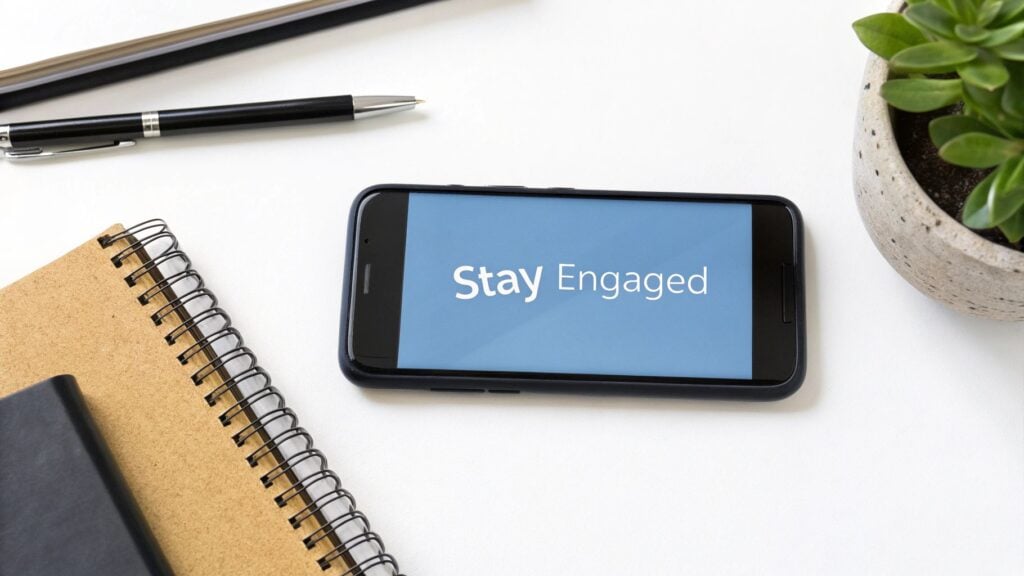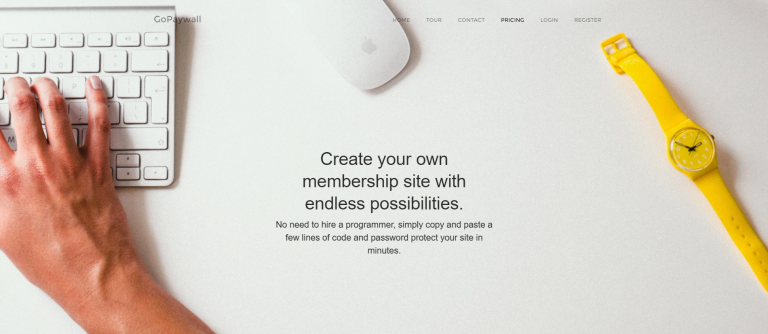How to Reduce Churn Rate and Keep Your Customers

To get a handle on churn, you first have to figure out why your customers are leaving. This isn’t the time for guesswork. You need to dig into cancellation feedback and user activity to find the top 3-5 reasons people are walking away, then build a targeted plan to fix those specific issues.
Why Your Customers Are Really Leaving
It’s so tempting to jump straight into “fixing” churn without really understanding it. I’ve been there. You see the numbers tick up, panic a little, and start throwing solutions at the wall, hoping something sticks. But before you can build a strategy that actually works, you have to get to the “why.”
This means becoming a bit of a detective. Your first clues are always in your cancellation feedback. When someone cancels, what reason do they give? Don’t just glance at these. Look for patterns. Is it pricing? Missing features? A string of bad support experiences? This is where you start.
Finding Patterns in Customer Behavior
Beyond what customers tell you, their actions tell an even more powerful story. A customer rarely decides to leave overnight. It’s usually a slow fade. They log in less often, use fewer features, or stop opening your emails. These are the breadcrumbs that lead straight to churn.
Tracking these behaviors lets you spot at-risk customers before they hit the cancel button. For instance, if a user hasn’t logged in for 30 days, that’s a massive red flag. This is your chance to reach out and see what’s going on before it’s too late.
Churn is a lagging indicator. It’s the final result of a problem that likely started weeks, or even months, ago. The real goal is to spot the early warning signs of disengagement so you actually have a chance to turn things around.
Learning to analyze customer feedback to stop SaaS churn is the fundamental first step. This is where you turn all that raw data into a retention plan that has a real shot at working.
To make this more concrete, here’s a breakdown of the most common churn drivers I see and what they actually look like in your data.
Top 5 Churn Drivers and How to Spot Them
This table breaks down common reasons customers leave and provides clear, actionable signals to look for in your user data.
| Churn Driver | What It Looks Like | Key Metric to Track |
|---|---|---|
| Poor Onboarding | Users never complete setup or use core features. They log in a few times and then disappear. | Feature Adoption Rate (within the first 7 days) |
| Missing Key Feature | Customers repeatedly search help docs for a feature you don’t have or request it from support. | Number of Support Tickets (by feature request) |
| Pricing/Value Mismatch | Usage drops off right before a renewal period, or they downgrade to a free plan. | Login Frequency (in the 30 days before renewal) |
| Bad Customer Support | A user has multiple unresolved support tickets or low CSAT scores after an interaction. | First Contact Resolution Rate and CSAT Scores |
| Product Bugs/Performance | Users experience frequent errors, slow load times, or file bug reports that go unresolved. | Number of Rage Clicks or Open Bug Reports per user |
By tracking these specific metrics, you move from vague feelings about why people are leaving to a data-backed list of problems you can actually solve.
Using Surveys to Get Honest Answers
Sometimes, the simplest way to get answers is just to ask. I’m not talking about a 20-question monster survey no one will fill out. I mean short, one- or two-question surveys sent at just the right moment.
- After Onboarding: “On a scale of 1-10, how easy was it to get started?”
- After a Support Interaction: “Did we solve your problem today?”
- A few months in: “What’s one thing we could do to make our product better for you?”
These little touchpoints give you a continuous stream of feedback, helping you separate minor annoyances from the major, churn-causing problems. Speaking of problems, sometimes churn is directly tied to how well customers are succeeding, which is why tracking metrics like the average online course completion rate can offer clues about engagement and whether they’re getting the value they paid for.
This infographic shows how you might analyze different feedback charts to spot these drivers.
Visualizing data this way makes it much easier to see the trends and decide which churn reasons need your attention right now.
2. Create an Onboarding Experience That Sticks
A customer’s first few days with your product are make-or-break. I like to think of it like a first date. If it’s confusing, boring, or just plain overwhelming, you probably aren’t getting a second one. This is exactly why a rock-solid onboarding experience is one of the most powerful tools you have to fight churn.

The goal here isn’t to show off every single feature you’ve spent years building. The real mission is to guide your new customer to their first “aha!” moment as fast as humanly possible. That’s the instant they truly experience your product’s core value and think, “Oh, I get it. This is exactly what I needed.”
Nail that early win, and they’re far more likely to stick around for the long haul. In fact, research shows that 68% of users are more loyal to businesses that invest in great onboarding and education.
Go Beyond the Standard Product Tour
We’ve all clicked through them, those generic, one-size-fits-all product tours. They point out buttons and menus but rarely connect those features to what you, the user, actually want to accomplish.
A much better approach is to ask one simple question the moment a user signs up: “What are you hoping to achieve with our product today?”
Their answer is your roadmap. It lets you tailor the entire onboarding flow to their specific goal, making it immediately relevant.
Imagine you run a course platform like LearnStream. A new user might tell you they want to:
- “Build my first online course.” Perfect. You can guide them straight to the course builder, showing them how to create modules and upload their first video.
- “Sell a digital download.” Great. You can skip all the course-creation noise and show them exactly how to set up a product page and connect a payment gateway.
- “I’m just exploring.” No problem. You can offer a broader overview or a short video showcasing what’s possible when they’re ready.
This simple step transforms the experience from a generic tour into a personal, guided session. You’re not just showing them a tool. You’re helping them solve their problem from minute one.
The best onboarding processes feel less like a manual and more like a helpful guide who knows exactly where you want to go. It’s about building momentum and confidence, not just showing off features.
Use Checklists to Guide and Motivate
People love checklists. There’s something deeply satisfying about ticking off an item. It provides a clear path forward and a little hit of accomplishment with every step.
An in-app onboarding checklist is a fantastic way to break down the setup process into small, manageable chunks. This isn’t a laundry list of every possible action. Instead, focus on the 3-5 key actions a user must take to get to that initial “aha!” moment.
A good checklist might look like this:
- Create your first project. (The foundational step)
- Invite one team member. (Encourages collaboration and makes the tool stickier)
- Complete your profile. (A simple task that helps with personalization)
- Watch our 2-minute quickstart video. (A low-effort way to get them oriented)
Each completed item should feel like a small victory. This builds the positive momentum needed to turn a brand-new user into an active, engaged customer who truly gets the value you offer.
Write Welcome Emails That Actually Help
Your welcome email is a crucial piece of the onboarding puzzle, but it’s so often wasted. Most are just a generic “Welcome to the family!” message that gets immediately archived and forgotten. This is a massive missed opportunity to stop churn before it even has a chance to start.
Instead, use that first email to set clear expectations and provide immediate value. A powerful welcome email does three things. It confirms their decision to sign up was a good one, it gives them a single, clear next step, and it tells them where to find help if they get stuck.
This simple structure turns your welcome email from a passive notification into an active part of their success journey. It reassures them, guides them, and shows that you’re there to support them, which is exactly the first impression you want to make.
Proactively Engage Customers Before They Go Quiet
Churn almost never happens overnight. It’s usually a slow fade, a quiet drift as a customer’s engagement with your product dwindles. The real secret to retention is keeping them actively plugged in and getting value long after that initial sign-up excitement has worn off.
Here, we’ll get into the proactive strategies that stop customers from slipping away in the first place.

I’ve learned the hard way that if you’re waiting for a customer to complain or ask for help, you’re already too late. The most effective way to cut down churn is to stay one step ahead, making your product an essential part of their workflow. You need to build a partnership, not just sell a tool.
This means moving from a reactive support desk to a proactive engagement strategy. You want to be the one reaching out with helpful advice, new tips, and quick check-ins before they even realize they need them.
Spotting At-Risk Customers Early
First things first: you need to know who to talk to. Most customers give off subtle warnings long before they hit the cancel button. Your job is to pick up on these signals so you can step in at just the right moment.
Predictive analytics tools can be a massive help here, identifying at-risk customers by flagging behaviors that signal they’re checking out. Some studies even show companies using these tools can slash churn by up to 15%.
But you don’t need a fancy, expensive system to get going. You can build your own “churn radar” simply by keeping an eye on a few key behaviors:
- A drop in logins or feature usage: This is the most obvious red flag. If a daily user suddenly logs in once a week, it’s time to find out why.
- Going dark on emails: When a customer who used to open every newsletter suddenly stops, they might be mentally unsubscribing from your brand.
- Lingering support tickets: An open, unresolved issue is a churn bomb waiting to go off. Frustration builds fast when problems aren’t solved.
- Ghosting your check-ins: If a customer repeatedly cancels or ignores your requests for a success call, they might be avoiding a tough conversation about their lack of results.
Tracking these signals helps you move from guessing who might leave to knowing who needs your attention now.
Personalize Your Outreach
Once you’ve identified a user who’s drifting, a generic “Hey, we miss you!” email is going straight to the trash. Effective re-engagement is all about personalization. People want to feel seen and understood, not like another entry on a spreadsheet.
For example, let’s say you notice a customer hasn’t touched a key feature that aligns perfectly with their stated goals. Send them a targeted, helpful message.
Something like: “I saw you’re working on building out your sales funnel, but you haven’t tried our new automated email sequence feature yet. Here’s a 2-minute video showing exactly how it can save you a ton of time.”
Proactive engagement isn’t about spamming users. It’s about delivering the right help, to the right person, at exactly the right time. This is how you prove your ongoing value and rebuild their connection to your product.
This approach turns a simple reminder into a valuable interaction that directly solves a problem for them.
Build a Community Around Your Product
One of the most powerful retention hooks you can create is making customers feel like they’re part of something bigger than themselves. A thriving community fosters a sense of belonging and transforms your product from a solo tool into a shared experience.
And it doesn’t have to be complicated to get started. You can build a strong community with a few simple initiatives:
- Launch an exclusive user group: A private forum, Slack channel, or Facebook group gives customers a place to ask questions, share wins, and connect with each other.
- Host regular webinars: Run events where users can learn about new features, hear from experts, or see how other customers are succeeding.
- Create customer spotlights: Feature your power users in blog posts or newsletters. It celebrates their success and gives other users a blueprint to follow.
These efforts create a sticky ecosystem around your brand. When customers build real relationships and find value beyond just the software, they have far more reasons to stick around. For a deeper look, check out these community engagement best practices to help you get started on the right foot.
By proactively reaching out, personalizing your communication, and fostering a true community, you can stop churn before it even becomes a thought. You’re not just selling a product. You’re building a partnership. And that’s a relationship customers will find much harder to walk away from.
Turn Customer Support into a Retention Engine

It’s easy to think of customer support as the team that just puts out fires. A customer hits a snag, they send a message, and the support team swoops in to fix it. End of story. But if you’re serious about cutting your churn rate, that view is way too small.
Every single support ticket is a fork in the road for your customer relationship. One path leads to that customer feeling heard, helped, and even more connected to your brand. The other path leads to frustration, and it’s often the last straw before they decide to cancel.
Exceptional customer support helps you prevent problems in the first place, build confidence, and remind customers why they chose you every single time they need a hand.
Speed Matters More Than You Think
In a world of instant everything, making a customer wait for help is painful. When someone is stuck, every minute that ticks by without a response amplifies their frustration. This isn’t just a feeling. It has a direct, measurable impact on your bottom line.
Improving your response time is one of the biggest levers you can pull to reduce churn. In fact, a staggering 68% of cancellations can be traced back to poor response times. Customers who are left waiting for more than two hours for a reply are four times more likely to leave.
On the flip side, businesses with an average first response time under one minute see a 42% lower churn rate. These numbers, highlighted in recent customer churn statistics and findings on synthicai.com, prove just how critical a quick, human touch is for keeping customers happy.
This doesn’t mean you need a massive team working around the clock. It’s about having the right systems in place to acknowledge and address issues fast, even if it starts with an automated message that says, “We’ve got your request and we’re on it.”
Empower Customers with a Robust Knowledge Base
The best support ticket is the one that never has to be written. Many customers would actually rather find the answers themselves. It’s faster and it puts them in control. A comprehensive, easy-to-search knowledge base is one of the smartest investments you can make in your entire support system.
A great knowledge base does more than just answer simple questions. It should be a living library of resources that helps your customers win. Think about including things like:
- Step-by-step guides: Show users exactly how to perform key tasks in your product.
- Video tutorials: Cater to visual learners with short, focused videos on common processes.
- Best practices and strategies: Go beyond the “how” and explain the “why,” helping users unlock more value.
- Troubleshooting articles: Get ahead of common errors by providing clear, simple solutions.
When you empower people to solve their own problems, you free up your support team to handle the more complex, high-touch issues that really need a human expert.
A support interaction is so much more than a solved ticket. It’s a chance to remind a customer why they chose you in the first place. It’s an opportunity to turn a moment of frustration into a moment of relief and gratitude, strengthening their bond with your brand.
Make Every Support Interaction Personal
When a customer does need to reach out, they want to talk to a person, not a robot reading from a script. Your support team needs to be trained to be empathetic, patient, and genuinely curious about the customer’s problem.
This means giving them the tools and the freedom to do their best work. They need access to a customer’s history. What plan are they on? What was their last support ticket about? Have they been using the product actively?
Context changes everything. When a support agent can say, “I see you were trying to set up your email integration last week, is this related to that?” it shows you’re paying attention. It turns a generic support exchange into a real conversation, which is a powerful way to build trust and fight churn.
Alright, we’ve covered a ton of ground. We’ve dug into the “why” behind churn, sketched out what a killer onboarding experience looks like, and talked about keeping customers hooked for the long haul.
Now it’s time to pull all those threads together. This is where we build a real, actionable plan to make a dent in your churn rate. Knowing the theory is one thing, but actually moving the needle requires a focused, organized approach.
Let’s turn these ideas into an ongoing process, not just a one-off project.
Prioritize for Maximum Impact
You can’t fix everything at once. If you try, you’ll just spread your team too thin and won’t make a real difference anywhere. The trick is to prioritize your efforts based on two simple factors: impact and effort.
Go back to the churn drivers you identified earlier. Which one is causing the most pain? That’s your high-impact target.
- High Impact, Low Effort: These are your quick wins. Start here, always. For example, if you found out your welcome email is confusing people, rewriting it is a small task that could have an immediate, positive effect on new users.
- High Impact, High Effort: These are your big, game-changing projects. Think overhauling your entire onboarding flow or building a customer community from the ground up. These are absolutely crucial, but they need proper planning.
- Low Impact, Low Effort: It’s fine to knock these out when you have some downtime, but don’t let them distract you from the bigger fish.
- Low Impact, High Effort: Avoid these like the plague. They’re a resource drain with almost no payoff.
This simple grid helps you focus your energy where it will make the biggest difference first.
Create Your Churn Reduction Checklist
A plan is good, but a checklist makes it real. It turns abstract goals into concrete tasks you can assign, track, and actually get done.
Below is a starter checklist based on everything we’ve covered. I highly recommend you tweak this to fit the specific churn drivers you’ve uncovered in your own business. This is your summary of the most important strategies for building a stronger, more resilient customer base.
An action plan turns good intentions into measurable progress. It’s the bridge between knowing what causes churn and actively preventing it. Don’t skip this step—it’s how you create real, lasting change.
To get you started, here’s a simple table to help organize your strategy.
Your Churn Reduction Strategy Checklist
This table summarizes some of the actionable steps we’ve discussed, helping you prioritize and track your churn reduction initiatives. Think of it as your command center for fighting churn.
| Area of Focus | Key Action | Tool or Metric |
|---|---|---|
| Onboarding | Map out the first “aha!” moment and guide users directly to it with an in-app checklist. | Time-to-Value (TTV) |
| Engagement | Identify at-risk users by tracking login frequency and feature usage. Proactively reach out. | Customer Health Score |
| Customer Support | Create a knowledge base with video tutorials for the top 5 most common support questions. | Ticket Deflection Rate |
| Feedback | Implement a one-question survey at the point of cancellation to gather honest feedback. | Cancellation Survey Responses |
| Communication | Set up behavior-triggered emails for users who haven’t used a key feature after 30 days. | Email Open & Click Rates |
Use this as a starting point and build it out with actions specific to your product and customers.
Measure What Matters
You can’t improve what you don’t measure. Your overall churn rate is the ultimate scoreboard, but it’s a lagging indicator. It tells you what already happened. To see if your plan is working in real-time, you need to watch the leading indicators.
These are the metrics that tell you if you’re moving in the right direction before the month ends:
- Feature Adoption Rate: Are more new users trying out your stickiest, most valuable features?
- Customer Satisfaction (CSAT) Scores: Are people happier after interacting with your support team?
- Net Promoter Score (NPS): Are you creating more promoters and fewer detractors over time?
Tracking these numbers gives you early feedback on your efforts long before they show up in your monthly churn report.
Build a Customer-First Culture
Ultimately, reducing churn isn’t just one person’s job. It has to be woven into the fabric of your entire company. From the engineers building the product to the marketers writing the ad copy, everyone needs to be thinking about how their work impacts the customer experience.
Share churn data and customer feedback widely across the company. Celebrate retention wins just as loudly as you celebrate new sales. When the whole team is aligned on keeping customers happy and successful, you build a powerful, company-wide engine for retention.
A great plan combines both proactive strategies and useful tools. For instance, you could even explore building an AI retention bot to actively combat churn to automate some of that proactive outreach.
This all feeds into creating a business that people want to stick with for the long haul. For more ideas on how to keep your audience engaged, our guide on membership retention strategies offers even more practical tips.
A Few Lingering Questions About Churn
We’ve walked through a lot of strategies for tackling churn, but I know there are always a few practical questions that come up once you start digging in. Let’s clear up some of the most common ones I hear from teams just like yours.
What’s a “Good” Churn Rate, Really?
Honestly, this is the million-dollar question, and the answer is always, “it depends.” There’s no magic number that applies to every business. The real benchmarks are dictated by your industry and, more importantly, who your customers are.
For a SaaS company selling to small businesses, a monthly churn rate of 3-5% is pretty standard. But if you’re selling enterprise-level contracts, that number absolutely has to be below 1%. Big deals mean fewer customers, so each loss hits much harder.
Here’s my advice: don’t get hung up on industry averages.
Your most important metric isn’t some generic benchmark. It’s your churn rate this quarter compared to last quarter. The real win is seeing that number consistently trend downward. That’s the sign of a healthy, improving business.
How Long Until I Actually See Results?
This is where you have to play both the short game and the long game. You’ll see the impact of some changes almost immediately, while others require a lot more patience.
For instance, if you roll out a new 24/7 support channel or slash your average ticket response time, you could see a drop in cancellations related to “poor support” within a single month. These are the quick wins. They build momentum and prove to your team that your efforts are paying off.
Bigger, more foundational changes are a different story. A complete overhaul of your onboarding flow or a project to build a thriving customer community from the ground up isn’t going to move the needle overnight. Those kinds of strategic initiatives can easily take six months or more to show a significant, lasting impact on your overall churn rate.
Should I Bribe Canceling Customers with Discounts?
It’s so tempting, isn’t it? A customer clicks “cancel,” you pop up a “25% off for three months” offer, and they stick around. Problem solved? Not usually.
Offering a last-minute discount is a band-aid solution. It might keep a customer on board for another billing cycle or two, but it rarely fixes the underlying reason they wanted to leave in the first place. Once the discount expires, they’re gone.
I’m not saying never use them, but they should be a scalpel, not a sledgehammer.
A much smarter approach is to use the cancellation flow as a final opportunity for a real conversation. Instead of an automated offer, try to connect them with a customer success manager who can actually diagnose and solve their problem. If you learn that their issue is genuinely about budget constraints, then a temporary discount or a downgrade to a more affordable plan becomes a strategic move, not just a desperate one.






